Type ii pneumocytes - Study guides, Class notes & Summaries
Looking for the best study guides, study notes and summaries about Type ii pneumocytes? On this page you'll find 148 study documents about Type ii pneumocytes.
Page 4 out of 148 results
Sort by
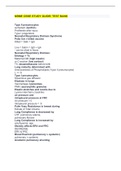
-
NBME CBSE STUDY GUIDE/ QUESTION BANK
- Exam (elaborations) • 145 pages • 2023
-
- $13.49
- + learn more
NBME CBSE STUDY GUIDE/ TEST BANK Type II pneumocytes surfactant (lecithin) Proliferate after injury Type I progenitors Neonatal Respiratory Distress Syndrome Polio live v killed vaccine Killed = Salk = IgG Live = Sabin = IgG + IgA - can be shed in feces Neonatal Respiratory Distress: Etiology + Tx Maternal DM (high insulin) or C-section (low cortisol) TX: dexamethasone before birth Lung maturity determined with Amniocentesis of Phospholipids (*type II pneumocytes) L >>...

-
CCRN Neonatal QUESTIONS & ANSWERS (LATEST UPDATE) best guide for your exam
- Exam (elaborations) • 25 pages • 2024
-
Available in package deal
-
- $12.99
- + learn more
CCRN Neonatal QUESTIONS & ANSWERS (LATEST UPDATE) best guide for your exam A deformation is a(n) - ANSWER- abnormality caused by unusual mechanical forces on normal tissue. A low birth weight infant's temperature increases during skin-to-skin care. This is an example of heat transfer by - ANSWER- conduction. At the onset of labor the release of catecholamines stimulates - ANSWER- increased absorption of lung fluid. An edematous, bruised lesion on the right anterior scalp where the v...
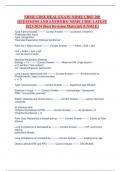
-
NBME CBSE REAL EXAM/ NBME CBSE 200 QUESTIONS AND ANSWERS/ NBME CBSE LATEST 2023-2024 (Best Revision Material) (USMLE)
- Exam (elaborations) • 149 pages • 2024
- Available in package deal
-
- $21.49
- + learn more
NBME CBSE REAL EXAM/ NBME CBSE 200 QUESTIONS AND ANSWERS/ NBME CBSE LATEST (Best Revision Material) (USMLE) Type II pneumocytes --------- Correct Answer -------- surfactant (*lecithin*) Proliferate after injury Type I progenitors *Neonatal Respiratory Distress Syndrome* Polio live v killed vaccine --------- Correct Answer -------- Killed = Salk = IgG Live = Sabin = IgG + IgA - can be shed in feces Neonatal Respiratory Distress: Etiology + Tx --------- Correct Answer -------- Maternal...
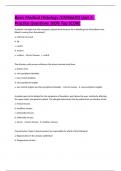
-
Basic Medical Histology (GMS6630) Unit 4 - Practice Questions 100% Top SCORE
- Exam (elaborations) • 17 pages • 2024
-
Available in package deal
-
- $9.49
- + learn more
A patient is brought into the emergency department because she is bleeding from Kiesselbach area. Blood is issuing from the patient's a. external ear canal. b. lip. c. nostril. d. rectum. e. urethra. - Correct Answer c. nostril. The olfactory cells possess olfactory cilia whose terminal ends have a. dynein arms. b. nine peripheral doublets. c. two central doublets. d. nine peripheral singlets. e. two central singlets and nine peripheral doublets. - Correct Answer d. nine periph...
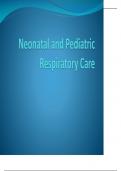
-
NEONATAL AND PEDIATRIC RESPIRATORY CARE PRESENTATION (100% CORRECR)
- Exam (elaborations) • 169 pages • 2024
-
- $17.99
- + learn more
Embryonic Development of the Lung A. Placental Gas Exchange: 1. The placenta is an organ that connects the developing fetus to the uterine wall to allow nutrient uptake, waste elimination and gas exchange via the mother’s blood supply. 2. The placenta functions as a feto-maternal organ with two components: the fetal placenta, which develops from the same blastocyst that form the fetus, and the maternal placenta, which develops from the maternal uterine tissue. I. Embryonic Developme...
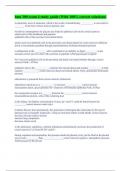
-
bms 300 exam 4 study guide (With 100% correct solutions)
- Exam (elaborations) • 8 pages • 2024
- Available in package deal
-
- $10.49
- + learn more
in mammals, most of ammonia, which is the result of metabolizing __________, is converted to ________ in the liver correct answers protein, urea Na-driven cotransporters for glucose are found in epithelial cells in the correct answers enterocytes of the duodenum and jujenum epithelial cells of the proximal convoluted tubule amino acids exit epithelial cells in the proximal convoluted tubule by correct answers diffusion down a concentration gradient through transmembrane facilitated transp...
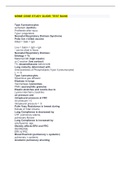
-
NBME CBSE STUDY GUIDE/ TEST BANK
- Exam (elaborations) • 145 pages • 2023
-
Available in package deal
-
- $13.49
- + learn more
NBME CBSE STUDY GUIDE/ TEST BANK Type II pneumocytes surfactant (lecithin) Proliferate after injury Type I progenitors Neonatal Respiratory Distress Syndrome Polio live v killed vaccine Killed = Salk = IgG Live = Sabin = IgG + IgA - can be shed in feces Neonatal Respiratory Distress: Etiology + Tx Maternal DM (high insulin) or C-section (low cortisol) TX: dexamethasone before birth Lung maturity determined with Amniocentesis of Phospholipids (*type II pneumocytes) L >>...

-
CCRN Neonatal Exam Questions And Answers
- Exam (elaborations) • 24 pages • 2024
-
- $11.99
- + learn more
CCRN Neonatal Exam Questions And Answers A deformation is a(n) - ANS abnormality caused by unusual mechanical forces on normal tissue. A low birth weight infant's temperature increases during skin-to-skin care. This is an example of heat transfer by - ANS conduction. At the onset of labor the release of catecholamines stimulates - ANS increased absorption of lung fluid. An edematous, bruised lesion on the right anterior scalp where the vacuum was applied. This lesion has...
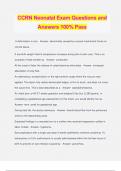
-
CCRN Neonatal Exam Questions and Answers 100% Pass
- Exam (elaborations) • 35 pages • 2024
- Available in package deal
-
- $13.49
- + learn more
CCRN Neonatal Exam Questions and Answers 100% Pass A deformation is a(n) - Answer- abnormality caused by unusual mechanical forces on normal tissue. A low birth weight infant's temperature increases during skin-to-skin care. This is an example of heat transfer by - Answer- conduction. At the onset of labor the release of catecholamines stimulates - Answer- increased absorption of lung fluid. An edematous, bruised lesion on the right anterior scalp where the vacuum was applied. This les...

-
BMS 300 Exam 4 corrections (Verified)
- Exam (elaborations) • 7 pages • 2024
- Available in package deal
-
- $9.99
- + learn more
Ouabain is a plant toxin that blocks the Na/K ATPase. You would expect to find labeled ouabain in the: a. apical membranes of the epithelial cells of the descending limb of the loop of the nephron b. in the apical membranes of the epithelial cells of the proximal convoluted tubule c. in the basilar membranes of the epithelial cells in the thick segment of the ascending limb d. in the basilar membranes of the epithelial cells of the distal convoluted tubule e. c and d are correct correct a...

Study stress? For sellers on Stuvia, these are actually golden times. KA-CHING! Earn from your study resources too and start uploading now. Discover all about earning on Stuvia


